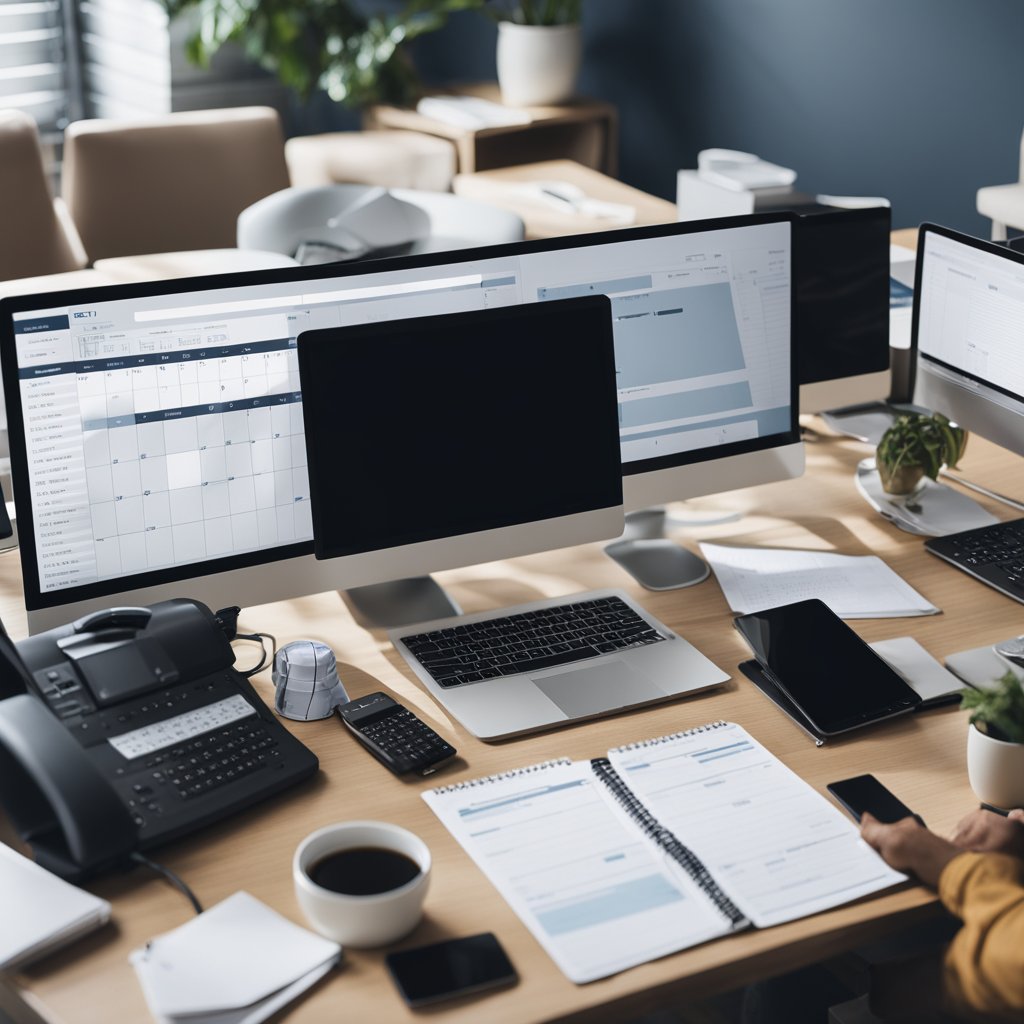The Best Apps to Organize Your Day and Stay Productive: Enhance Your Efficiency and Manage Your Time Effectively
By Alex Reynolds |

The Best Apps to Organize Your Day and Stay Productive: Enhance Your Efficiency and Manage Your Time Effectively
With the fast pace of life today, staying organized and productive can be a challenge. The best apps to organize your day and stay productive can help streamline tasks, set reminders, and enhance time management skills. These digital tools are designed to fit into everyday routines, making it easier to keep track of commitments without feeling overwhelmed.
From to-do lists to calendar apps, there are many options available that cater to different needs. With the right app, individuals can prioritize tasks and break down larger projects into smaller, manageable steps. This not only boosts productivity but also reduces stress.
In this article, readers will discover various app recommendations tailored to help maximize efficiency. By leveraging technology effectively, anyone can take control of their day and accomplish more with less effort.
Understanding Productivity Apps
Productivity apps are tools designed to help individuals manage their tasks and time more effectively. They offer various features that can enhance personal organization, focus, and efficiency.
What Are Productivity Apps?
Productivity apps are software applications that assist users in organizing their daily activities. These apps can take many forms, including to-do lists, calendars, note-taking, and time management tools.
Common types include:
- To-Do Lists: Help users track tasks and deadlines.
- Calendars: Assist in scheduling events and appointments.
- Note-Taking Apps: Allow users to capture ideas and information quickly.
Some examples of popular productivity apps are Todoist, Trello, and Evernote. These applications are available across platforms, including mobile and desktop devices, making them accessible anytime.
Benefits of Using Productivity Apps
Using productivity apps can lead to significant improvements in time management and personal efficiency.
Key benefits include:
- Enhanced Organization: Users can keep all their tasks in one place.
- Time Savings: These apps help prioritize tasks, allowing for efficient use of time.
- Increased Focus: Features like reminders and notifications help users stay on track.
- Collaboration: Many apps support teamwork, making it easier for groups to work together on projects.
By implementing these tools, individuals may find it easier to achieve their goals and stay productive throughout the day.
Criteria for Choosing Productivity Apps
Selecting the right productivity app involves careful consideration of various factors. Users should evaluate ease of use, available features, and how well the app works with other tools. Additionally, security measures are crucial to ensure personal data remains protected.
User Experience
User experience is vital when choosing a productivity app. An intuitive interface allows users to navigate features without frustration. Users benefit from an app that minimizes complexity while maximizing efficiency.
Apps should offer customizable settings to accommodate individual preferences. A clean layout helps users focus on tasks without distractions. For a productive experience, apps must prioritize smooth interactions and quick access to essential tools.
Features & Tools
The features and tools offered by a productivity app can significantly impact its effectiveness. Look for apps that include task management, calendar integration, and reminders. These tools help users organize their day and stay on track.
Collaboration features are also important. Many apps now allow users to share tasks with teams or family members, enhancing teamwork. Additional tools, such as note-taking and file attachments, can increase productivity by keeping everything in one place.
Compatibility & Integration
Compatibility and integration with other software are crucial for productivity apps. Users should verify that their chosen app works well with existing tools like email platforms or project management software. This ensures seamless workflow without having to switch between multiple applications.
Integration with cloud-based services allows users to access their data from any device. Apps that sync across smartphones, tablets, and computers create a more flexible working environment. This reduces the risk of losing important information and allows users to stay productive on the go.
Security & Privacy
Security and privacy are top concerns when selecting a productivity app. Users need to ensure that their personal information and data are safeguarded. Look for apps that offer encryption to protect sensitive data from unauthorized access.
Privacy policies should clearly outline how user data is collected, used, and stored. Apps that provide options for two-factor authentication add an extra layer of security. Users can feel more confident knowing their information is secure, allowing them to focus on their tasks.
Top Calendar and Scheduling Apps
Calendar and scheduling apps help individuals manage their time and tasks effectively. The following popular options offer features that can enhance productivity and organization throughout the day.
Google Calendar
Google Calendar is a widely used scheduling app known for its simplicity and integration with other Google services. Users can create events, set reminders, and share calendars with others.
Key features include:
- Event Creation: Users can easily add events and invite guests.
- Reminders: Custom reminders keep users on track with tasks and appointments.
- Integration: It syncs with Gmail, allowing automatic event creation from emails.
The mobile app provides notifications and allows access from any device. Google Calendar supports color coding for events, making it visually easy to categorize tasks. It’s an excellent tool for personal and team use.
Microsoft Outlook
Microsoft Outlook offers robust calendar features as part of its email client. It combines email management with scheduling, making it convenient for users.
Highlights include:
- Calendar Sharing: Users can share calendars with colleagues.
- Task Integration: Users can create tasks linked to specific calendar events.
- Meeting Tools: Outlook provides features for scheduling meetings, including availability checks.
The user interface is straightforward, making navigation simple. Outlook also integrates well with other Microsoft applications, enhancing collaboration. Notifications help users keep track of meetings and deadlines.
Top Task Management Apps
Effective task management apps help individuals streamline their workflow, prioritize tasks, and boost productivity. Here are some leading options to consider.
Todoist
Todoist is a popular task management tool designed for simplicity and efficiency. Users can easily create, organize, and schedule tasks with just a few clicks.
Key features include:
- Task Prioritization: Users can assign priority levels to tasks, helping them focus on what matters most.
- Recurring Due Dates: This function allows users to set up tasks that repeat daily, weekly, or monthly.
- Collaboration: Users can share projects and tasks with others, enhancing teamwork.
Its clean interface and intuitive design make it suitable for both personal and professional use. Integration with other applications like Google Calendar adds further capabilities.
Asana
Asana is geared towards team collaboration and project management. It allows users to track project progress and manage tasks efficiently.
Key highlights include:
- Project Templates: Users can access various templates to kick-start their projects.
- Timeline View: This visual tool helps teams see project schedules and deadlines at a glance.
- Custom Fields: Users can tailor projects to their specific needs.
Asana is particularly helpful for larger teams, providing insights on project status and workload distribution. Its flexibility accommodates various project styles, making it a top choice for many businesses.
Trello
Trello uses a card-based layout to help users organize tasks visually. It is especially effective for managing projects in a collaborative environment.
Key aspects are:
- Board System: Users can create boards for different projects and fill them with cards representing tasks.
- Drag-and-Drop Functionality: This feature makes it easy to move tasks between different stages of completion.
- Checklists and Due Dates: Each card can contain a checklist, and users can set due dates for tasks.
Trello’s visual approach allows users to quickly understand project status. Its integration with other tools enhances its functionality, making it a favorite among project managers.
Top Note-Taking Apps
Choosing the right note-taking app can boost organization and productivity. Some popular apps that stand out for their features are Evernote, OneNote, and Bear. Each of these apps has unique strengths that help users manage their notes effectively.
Evernote
Evernote is a versatile app that allows users to capture ideas in different formats. Notes can be text, images, audio, or file attachments. This flexibility makes it easy to gather information quickly.
The app also offers organizational tools like notebooks and tags. Notebooks group related notes, while tags help in finding specific content. Additionally, Evernote’s search feature is powerful. Users can search not only text but also text within images.
Evernote syncs across devices, so users can access notes anywhere. It has a free plan, but premium features require a subscription. Users appreciate its structured approach to note-taking.
OneNote
OneNote is part of the Microsoft Office suite and integrates well with other Microsoft apps. It offers a freeform canvas, making it easy to click anywhere and start typing. Users can also draw and annotate notes using a stylus or touchscreen.
Another strong feature is the ability to create sections and pages. This structure helps in organizing large amounts of information. OneNote syncs across devices as well, keeping notes accessible.
Collaboration is seamless, allowing users to share notes with others. This is especially useful for team projects or study groups. OneNote is free, making it an appealing option for many users.
Bear
Bear is simple and elegant, designed especially for Apple users. It works well across iPhone, iPad, and Mac devices. Users can write notes using markdown formatting, which enhances the writing experience.
Tags help in organizing notes, and its search function is efficient. Bear allows users to focus on writing without distractions. The app supports adding images, links, and more to enrich notes.
The free version has basic features, while a subscription unlocks advanced tools. These tools include syncing across devices and more export options. Users enjoy Bear for its clean interface and straightforward functionality.
Top Collaboration Tools
Effective collaboration tools can enhance team productivity and streamline communication. The following tools are essential for facilitating teamwork and ensuring smooth operations in both remote and in-person settings.
Slack
Slack is a popular messaging app designed for teams to communicate effectively. It allows users to create specific channels for different projects or topics, making it easy to keep discussions organized.
Key features include:
- Direct Messaging: Team members can send private messages to each other.
- File Sharing: Users can quickly share documents, images, and links.
- Integrations: Slack connects with various apps like Google Drive and Trello, enhancing workflow.
Its user-friendly interface helps teams stay connected and reduces email overload. Slack also supports voice and video calls, making discussions more interactive. This tool is ideal for businesses looking to improve communication among team members.
Microsoft Teams
Microsoft Teams is a comprehensive collaboration platform that combines chat, video meetings, and file storage. It is especially useful for organizations already using Microsoft 365 because it integrates seamlessly with other Microsoft apps.
Key advantages include:
- Video Conferencing: High-quality video calls with the ability to invite external guests.
- Document Collaboration: Teams can work on Word, Excel, and PowerPoint files in real-time.
- Task Management: Integration with Microsoft Planner for assigning and tracking tasks.
The built-in features promote teamwork and help streamline operations. The ability to store and share files securely within the platform is another significant benefit.
Zoom
Zoom is widely recognized for its video conferencing capabilities. It provides a reliable platform for virtual meetings, webinars, and online events.
Some important features are:
- High-Quality Video: Supports HD video and audio for clear communication.
- Screen Sharing: Participants can share their screens during a meeting for better collaboration.
- Breakout Rooms: Useful for large meetings, allowing smaller groups to discuss topics.
Zoom is easy to use, making it accessible for users of all skill levels. Its scheduling features and integrations with calendars make organizing meetings straightforward. This tool is crucial for teams needing effective virtual communication.
Integrating Productivity Apps into Your Workflow
Integrating productivity apps into daily routines can help individuals stay organized and enhance efficiency. These apps can streamline tasks and reduce distractions.
Key Steps for Integration:
- Identify Needs: Determine which tasks require support. This may include task management, scheduling, or communication.
- Select Apps: Choose apps that fit specific needs. Some popular options include:
- Todoist: for task management
- Trello: for project organization
- Google Calendar: for scheduling
- Link Apps: Many productivity apps allow users to connect with other tools. For instance, integrating Google Calendar with task apps helps in syncing deadlines.
Benefits of Integration:
- Centralized Information: Integrating different tools allows for all tasks and appointments to be in one place.
- Improved Focus: Reducing the need to switch between apps can help maintain concentration.
Example Workflow:
| Task | App Used | Integration Example |
|---|---|---|
| Task Management | Todoist | Sync tasks with Google Calendar for deadlines. |
| Project Tracking | Trello | Link Trello cards to relevant documents or notes. |
| Communication | Slack | Use Slack for team discussions on project progress. |
Simple integration practices can lead to better productivity in daily tasks. By taking these steps, individuals can maximize their workflow.
Customization and Personalization of Apps
Customization and personalization in apps play a crucial role in enhancing user experience. Many apps allow users to tailor their interfaces to suit their preferences.
Key Features of Customization:
- Interface Design: Users can often change themes, colors, and layouts. This helps create a visually appealing environment.
- Functional Tools: Many apps offer options to add or remove tools based on user needs. This ensures that users only see what is important to them.
- Notifications: Users can personalize notifications to receive alerts that matter. This minimizes distractions and keeps focus on tasks.
Personalization Benefits:
- Improved Efficiency: Customized tools allow users to work smarter, not harder.
- Enhanced Satisfaction: A personalized app experience can lead to higher satisfaction and retention.
- User Engagement: Users are more likely to engage with an app that feels tailored to their needs.
Some apps leverage data to offer personalized recommendations. For instance, they might suggest the best times to schedule tasks based on past behavior.
These personalized features are beneficial for managing daily tasks and boosting productivity. By allowing users to customize their experience, apps help them align tools with their personal work styles. This ultimately leads to better organization and efficiency in daily activities.
Measuring the Impact of Productivity Apps on Your Day
Productivity apps are tools that can help users manage their time better. To understand their impact, one can look at several key factors.
1. Time Tracking:
Many apps allow users to track how much time they spend on different tasks. This data helps identify where time is wasted and where improvements can be made.
2. Task Completion Rates:
By measuring how many tasks users complete daily or weekly, it becomes clear how effective these apps are. Higher completion rates often indicate better productivity.
3. Focus and Distraction Levels:
Some apps provide insights into focus versus distraction time. Users can see how often they shift between tasks and how it affects their productivity.
4. User Feedback:
Feedback from users can provide a qualitative measure of app effectiveness. Positive experiences often correlate with higher productivity levels.
5. Goal Achievement:
Users can set specific goals in these apps. Tracking progress toward these goals can show how much the apps contribute to achieving them.
With these measurements, users can assess which apps best enhance their daily productivity. Tools like Google apps can integrate various features to aid in this assessment. Understanding these elements allows users to choose the right applications for their needs.
Frequently Asked Questions
This section addresses common questions about productivity apps that can help users organize their day effectively. It covers popular apps for different devices and offers insights into features that enhance daily routines and task management.
What are some top-rated productivity apps for iPhone users?
For iPhone users, apps like Todoist, Trello, and Notion stand out. They offer tools for task management, collaboration, and project organization. These apps integrate well with other Apple services, making them easy to use.
Can you suggest free planning apps that can help organize daily tasks?
Free planning apps such as Google Keep, Microsoft To Do, and Any.do are excellent choices. Each of these apps allows users to create to-do lists and set reminders to keep daily tasks organized without any cost.
Which Android app is considered the most effective for daily organization and productivity?
For Android users, Todoist often ranks as the most effective productivity app. It features a user-friendly interface and allows users to manage tasks, set deadlines, and track progress efficiently.
What application is recommended for establishing and following a daily routine?
Habitica is highly recommended for establishing daily routines. This app gamifies habit tracking, helping users stay motivated while developing and maintaining productive habits.
What are the features of the highest-ranked personal organization app?
The highest-ranked personal organization apps typically include task management, calendar integration, reminders, and collaboration features. Apps like Notion and Trello illustrate this with customizable interfaces that fit individual needs.
How do dedicated organization apps compare to traditional note-taking for daily productivity?
Dedicated organization apps offer more structured tools for tracking tasks compared to traditional note-taking. They focus on productivity with features like reminders and categories, which enhance daily planning and execution.


